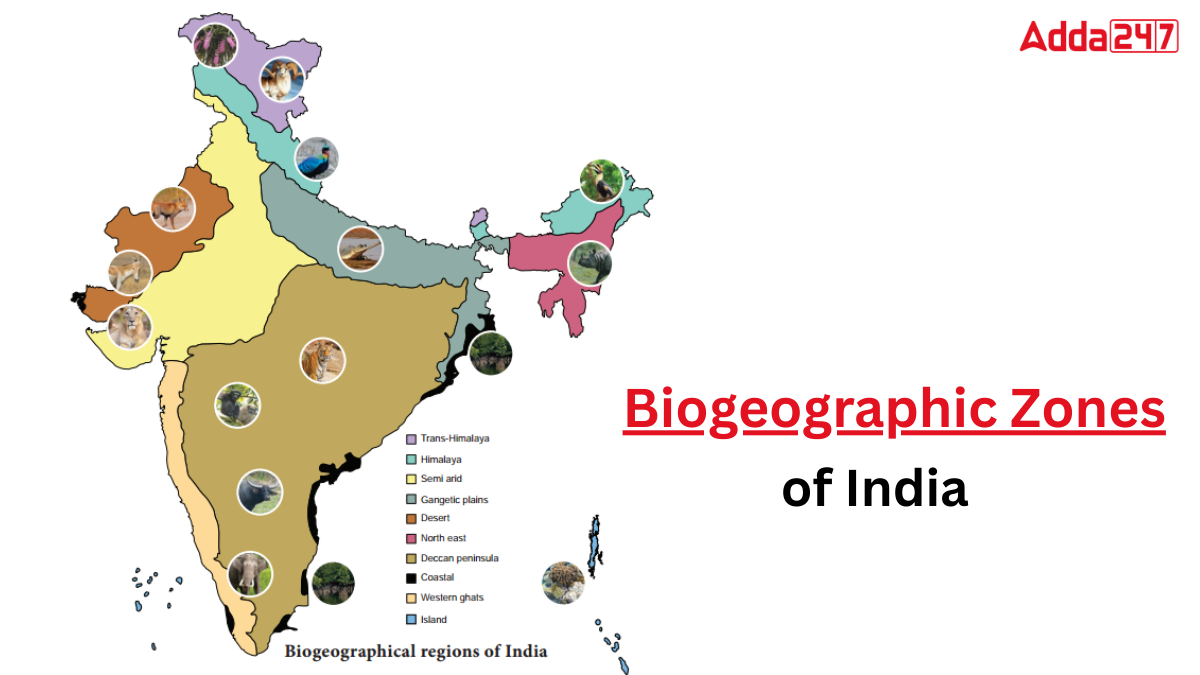India is a land of great natural beauty with many kinds of landscapes like mountains, forests, deserts, rivers and seas. To study and protect nature properly, scientists have divided the country into different natural regions. These special regions are based on the type of land, weather, plants and animals found there. Each region has its own unique features and plays an important role in conserving India’s biodiversity.
What is Biogeography?
Biogeography is the study of how animals, plants and ecosystems are spread across the world and how they change over time. It helps in understanding biodiversity patterns and protecting endangered species.
How many Biogeographic Zones are there in India?
India has 10 biogeographic zones, which are special regions divided based on natural features like climate, animals, plants and land types. These zones include the Himalayas, deserts, coastal areas and more. Each zone has its own unique wildlife and environment, helping to protect India’s rich biodiversity and natural beauty.
List of Biogeographic Zones in India
India has 10 biogeographic zones. These zones are:
| Biogeographic Zones | Area (in sq. km) | Percentage of India’s Land Area |
| Trans-Himalayan Region | 184,823 | 5.62% |
| Himalayan Zone | 210,662 | 6.41% |
| Indian Desert Zone | 215,757 | 6.56% |
| Semi-arid Zone | 545,950 | 16.60% |
| Western Ghats | 132,606 | 4.03% |
| Deccan Plateau | 1,380,380 | 41.99% |
| Gangetic Plain | 354,782 | 10.79% |
| North East Region | 82,813 | 2.52% |
| Islands | 171,341 | 5.21% |
| Coastal Region | 8,249 | 0.25% |
Trans Himalayan Region
This cold, dry region includes Ladakh, parts of Jammu and Kashmir, North Sikkim, Lahaul and Spiti. It covers 5.6% of India’s land. The region supports rare animals like the Snow Leopard and Black-necked Crane. With limited plants, it is home to many unique species and is a very sensitive ecosystem.
Himalayan Zone
Making up 6.4% of India’s area, this zone has the highest mountains, rich forests and many habitats. Found in East, West and Central Himalayas, it is home to rare animals like the Tahr, Bharal, Ibex, Markhor, Musk Deer and Hangul. The region is rich in biodiversity and supports many endangered species.
Indian Desert Zone
Located west of the Aravalli hills, this dry region includes Rajasthan’s deserts and Gujarat’s salt flats. The land is flat and sandy, supporting endangered animals like the wolf, desert cat and bustards. The harsh environment still supports life in grassy patches. It plays an important role in India’s desert ecosystems.
Semi-arid Zone
Covering 16.6% of India, this area lies between deserts and forests. It includes Delhi, Haryana, Punjab plains and parts of Gujarat and Rajasthan. Vegetation is patchy with shrubs, grass and dry forests. Animals like lions, jackals and wolves live here. This zone has dry soil and irregular rainfall but high animals biomass.
Western Ghats
This mountain range runs along India’s west coast from Gujarat to Kerala. Covering 4% of the land, it is a major biodiversity hotspot with tropical forests. Over 1,500 plant species are unique to this area. Endangered animals like the Lion-Tailed Macaque, Nilgiri Tahr and Malabar Grey Hornbill live here.
Deccan Plateau
This is India’s largest biogeographic zone, covering 42% of the land. It includes Madhya Pradesh, Maharashtra, Odisha and others. The region has hill ranges, deciduous forests and diverse animals like elephants, nilgai, gaur and barking deer. It lies in a semi-arid rain shadow area, supports rich wildlife and forests.
Gangetic Plain
This flat region covers 10.8% of India and stretches from Rajasthan to West Bengal. It’s highly populated and mostly used for farming. Forests in the Terai-Bhabar areas support animals like rhinos, swamp, deer, hog deer and elephants. It’s known for its uniform land and rich soil, ideal for agriculture.
North East Region
This region covers 5.2% of India and includes Assam, Meghalaya and others. It connects the Himalayas and peninsular India. Rich in unique plants and animals, it is both a biodiversity hotspot and a passageway for many species. Some plants and animals are found only in specific hills like the Khasi Hills.
Islands
Islands make up only 0.3% of India’s land and include Lakshadweep (Arabian Sea) and Andaman & Nicobar (Bay of Bengal). These islands have tropical evergreen forests, coral reefs and rare wildlife like the Narcondam hornbill. The Andaman Islands hold India’s only island-specific biodiversity. Lakshadweep has coral islets but almost no natural forest.
Coastal Region
This zone includes India’s 5,423 km long coastline from Gujarat to West Bengal. It covers 2.5% of the land. The region has beaches, mangroves, coral reefs and sea grass beds. Coastal areas support rich marine life. The Lakshadweep islands, though crowded, have coral reefs and diverse sea species, but little natural greenery.
Major Environmental Challenges
- Climate change affecting rainfall and temperature patterns.
- Deforestation and habitat destruction reducing biodiversity.
- Drying rivers and aquifer depletion.
- Pollution, urbanization ad overexploitation of resources.
- Loss of endangered species and ecosystem imbalance.




 Which City is known as the City of Bambo...
Which City is known as the City of Bambo...
 Who was the First Home Minister of India...
Who was the First Home Minister of India...







